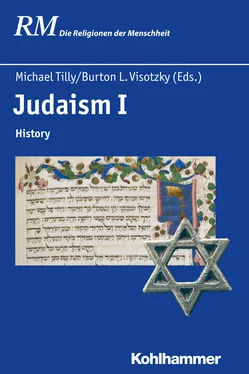3 The Resilience of Jews and Judaism in Late Roman-Byzantine Eretz Israel
Prof. Dr. Lee I. Levine of the Hebrew University of Jerusalem discusses the rabbinic movement and the Jews in the Land of Israel, challenging the traditional view of decline with an exposition of the vibrance of Judaism, as Christianity emerges in the Byzantine Empire. Levine explains that two phenomena from the Late Roman period have gained wide acceptance over the past generation and have revised our understanding of Jewish history. The first is a reassessment of the economic, political, and cultural situation in the province generally and of the Jews in particular. The second and third centuries—the Judea-based Bar-Kokhbah revolt notwithstanding—were a period of peace and stability throughout the province. Not only did the Jewish cities of Tiberias and Sepphoris expand in this era, but synagogue buildings were constructed in the third century following a hiatus of several centuries.
The second phenomenon that has revolutionized our understanding was the establishment of the Jewish Patriarchate, a new political-communal office recognized by Rome and intended to instill a sense of autonomy and confidence within the Jewish community. Rome, for its part, welcomed Jews into the municipal curiae with the provision that nothing was to interfere with their religious observance. Traditions reflecting sympathetic relations between Severan emperors on the one hand and the Jews and Judaism on the other are noted in the fourth century.
The third century also marked a new stage in the development of art as a form of religious expression, appearing on mosaic floors, walls, and architectural elements in pagan and Jewish contexts. Literary activity among the rabbis found expression in the compilation of tannaitic halakhic and midrashic treatises, including at least one that was influenced by a genre known in the Roman world. The archaeological finds from more than one hundred synagogues in ancient Palestine, almost all in the Galilee and Golan dating to Late Antiquity, in addition to the rich variety of artistic and epigraphic remains, demonstrate the multifaceted cultural and religious components within these communities. The construction of monumental synagogue buildings points to political standing and economic means of these Jewish communities.
Dr. Geoffrey Herman, of the École Pratique des Hautes Études, Paris, surveys Judaism in Babylonia from 226–650 CE. Our foremost source is the Babylonian Talmud. Indirect sources are classical authors, Persian epigraphic sources, or Syriac-Christian literature.
Jewish communities were found from the southern boundary of Mesene to Anbar in the North and were dotted along the Euphrates and Tigris, and beside the canals that crossed between the two rivers. The Jews were an agrarian society. Others worked in linen, flax, or silk, in live-stock, or vegetable gardening.
Jews maintained synagogues where they gathered on Sabbath mornings. Women had a subordinate role in public society. Most of the occupations of women were not different than in other ancient societies. Family structure was traditional. A young age for marriage was encouraged.
Jews encountered the Persian administration through the occasional billeting of soldiers or the presence of Persian nobles and overseers. Taxation also brought the Jews into direct contact with the administration. As inhabitants of a Persian empire, Jews in Babylonia came into regular contact with Persian language and culture, which left its mark on Jewish thought. The dominant religion in the Sasanian Empire was Zoroastrianism, and some of its more pronounced features were known to the Jews. Magical practice was known to all. The Talmud is brimming with material of a magical nature. The biblical legacy was of greatest importance for the identity of Babylonian Jews.
The Rabbis emerged as the major intellectual force, transforming not only the lives of Babylonian Jews, but Jewish religion and culture until today. The Rabbinic revolution was achieved through education. The Rabbis maintained the supreme value of the study of the Torah, and Rabbinic students were expected to subordinate themselves to a master and dedicate themselves to study.
There are signs of friction between Rabbis and other Jews. Leadership known as the resh galuta or Exilarch emerged, who professed to be the scion of the House of David. The Exilarchate could function as a source of immense prestige. As Babylonian Jewry grew in importance, a dynamic of regional rivalry developed between it and the Jews of Palestine. The Exilarch symbolically embodied Babylonia’s alleged ascendancy over the Jewish center in Palestine and the rest of the Jewish world.
5 Jews and/under Islam, 650–1000 CE
Dr. Phillip Lieberman of Vanderbilt University writes that with the rise of Islam in the early 7 thcentury CE, Jews were concentrated in oases such as Yathrib (later called Medina) and Khaybar. Some, like their brethren in Babylonia and the Land of Israel, were involved in agriculture. Others were involved in trading and crafts. Islamic histories may have set up Jews as mighty imagined enemies even where the actual number of Jews may have been small. The Jewish population in North Africa is known from Roman history and the presence of Jews is well-attested across the southern Mediterranean.
The Pact of ʿUmar served as a contract between Muslim rulers and subject peoples. This agreement offered dhimmī peoples relative stability and security, even if its provisions might have hampered their upward mobility. Rabbinic academies of Babylonia and the Land of Israel provided succor to the Jews of the Mediterranean Basin and the Iberian Peninsula, offering legal opinions on all aspects of daily life. There was competition between the academies of Babylonia and the Land of Israel for the loyalty of communities in the Diaspora. Jewish courts adjudicated matters, although Jews also had the ability to seek recourse in Islamic courts.
The Cairo Genizah provides much detail about urban life in Fusṭāṭ and other cities. Genizah documents suggest a population well integrated socially and economically into Islamic society. There is evidence of prominent women who served at the hub of trading networks, yet much of women’s economic and social activity was centered on the home. In contrast with Christian Europe, the practice of polygyny persisted in the Jewish community.
A dispute concerning the succession of the Jewish Exilarch in 760 CE led to a schism by Anan b. David. The rejection of rabbanite exegesis and a scripturalist approach to the Bible of these »Karaites« was part of a long-standing internal dispute. Religious and communal life was organized around the synagogue. In Fusṭāṭ, there were distinct synagogues for those adhering to the rabbis’ Palestinian rite, the Babylonian rite, and the synagogue of the Karaites.
6 Judaism in the Middle Ages 1000–1500
Dr. Robert Chazan of New York University covers Judaism’s shift from its Mediterranean orbit to Europe. The small Jewish community in Northern Europe around the year 1000 became a vigorous branch of the Jewish people. Christian rulers perceived Jews as useful for economic improvement. Anti-Jewish animosity and violence was manifest. In 1095, Pope Urban II announced an undertaking to recapture the sites of Christianity in the Holy Land. Anti-Jewish crusading violence reflected popular resistance to Jewish settlement in northern Europe. Yet French Jewry produced the first major classics of literature to emerge in Europe.
The Church prohibited Christians taking interest from other Christians, so finance became a Jewish specialty. Allegations of Jewish murder of Christian youngsters began to spread during the twelfth century. King Philip Augustus of France instituted a new policy toward his Jews: confiscation of Jewish goods; a remission of debts owed to Jews; and finally, expulsion.
Читать дальше







